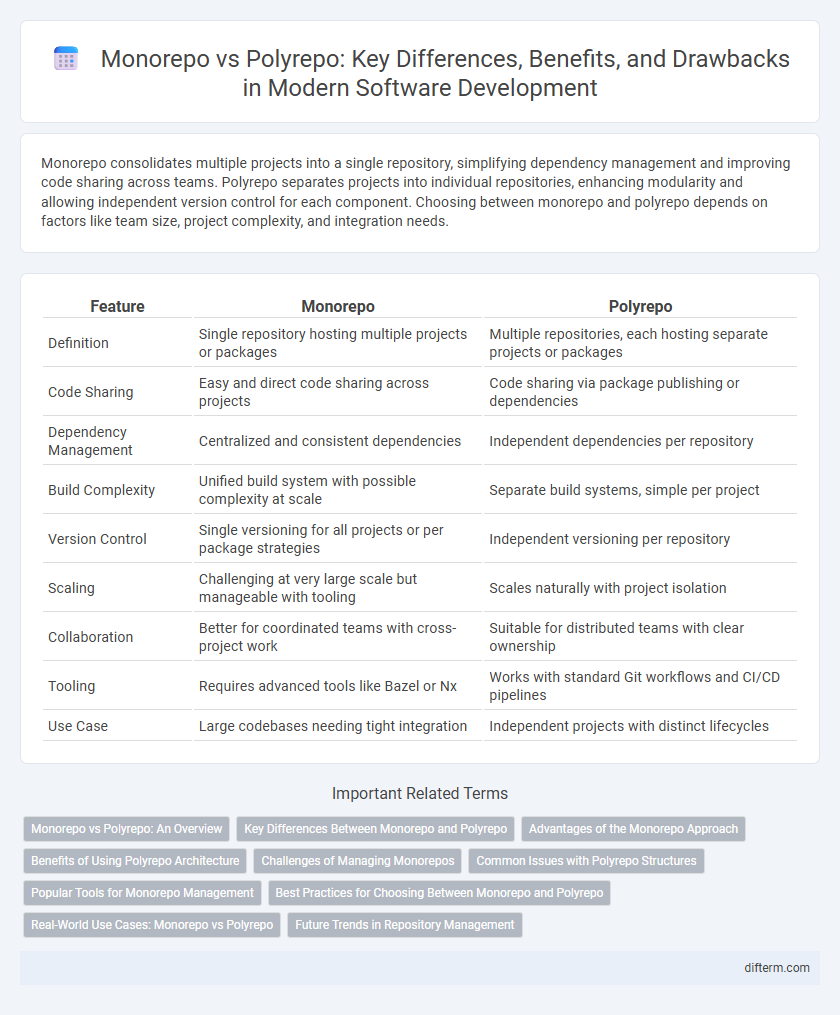Monorepo consolidates multiple projects into a single repository, simplifying dependency management and improving code sharing across teams. Polyrepo separates projects into individual repositories, enhancing modularity and allowing independent version control for each component. Choosing between monorepo and polyrepo depends on factors like team size, project complexity, and integration needs.
Table of Comparison
| Feature | Monorepo | Polyrepo |
|---|---|---|
| Definition | Single repository hosting multiple projects or packages | Multiple repositories, each hosting separate projects or packages |
| Code Sharing | Easy and direct code sharing across projects | Code sharing via package publishing or dependencies |
| Dependency Management | Centralized and consistent dependencies | Independent dependencies per repository |
| Build Complexity | Unified build system with possible complexity at scale | Separate build systems, simple per project |
| Version Control | Single versioning for all projects or per package strategies | Independent versioning per repository |
| Scaling | Challenging at very large scale but manageable with tooling | Scales naturally with project isolation |
| Collaboration | Better for coordinated teams with cross-project work | Suitable for distributed teams with clear ownership |
| Tooling | Requires advanced tools like Bazel or Nx | Works with standard Git workflows and CI/CD pipelines |
| Use Case | Large codebases needing tight integration | Independent projects with distinct lifecycles |
Monorepo vs Polyrepo: An Overview
Monorepos consolidate multiple projects within a single repository, enabling streamlined dependency management and simplified code sharing across teams. Polyrepos maintain separate repositories for each project, promoting isolation and easier version control but potentially increasing integration complexity. Choosing between monorepo and polyrepo depends on factors like team size, project scale, and deployment frequency, with monorepos favored for large codebases requiring tight collaboration.
Key Differences Between Monorepo and Polyrepo
Monorepos centralize all codebases into a single repository, enabling atomic commits and easier code sharing across projects, while polyrepos isolate each project in its own repository, enhancing independent deployment and granular access control. Monorepo setups often benefit from unified versioning and simplified dependency management, whereas polyrepos reduce repository size and foster autonomy for distributed teams. Tooling complexity and scalability challenges differ, with monorepos requiring robust build systems to handle scale, and polyrepos demanding integration strategies for cross-repository collaboration.
Advantages of the Monorepo Approach
Monorepo offers streamlined dependency management by housing all codebases within a single repository, improving consistency and reducing version conflicts. Centralized collaboration enhances visibility across teams, facilitating coordinated development and simplifying code refactoring. Unified tooling and standardized processes increase productivity, enabling seamless integration and continuous deployment workflows.
Benefits of Using Polyrepo Architecture
Polyrepo architecture enhances codebase modularity by isolating repositories, simplifying version control and reducing merge conflicts. It enables teams to independently deploy and update services, accelerating development cycles and improving scalability. Furthermore, polyrepo supports specialized access control, allowing fine-grained permissions and better security management across projects.
Challenges of Managing Monorepos
Managing monorepos presents challenges such as complex dependency management, which can lead to longer build times and increased difficulty in isolating faults. The scale of a monorepo often requires advanced tooling and robust version control strategies to handle simultaneous contributions from multiple teams. Scalability issues arise as the codebase grows, demanding efficient CI/CD pipelines and fine-grained access controls to maintain productivity and code quality.
Common Issues with Polyrepo Structures
Polyrepo structures often suffer from inconsistent dependency versions, causing integration challenges across projects. Managing cross-repository changes requires complex coordination and frequent updates to synchronize codebases. Fragmented version control and scattered documentation lead to reduced visibility and increased overhead in ensuring system-wide consistency.
Popular Tools for Monorepo Management
Popular tools for monorepo management include Bazel, Nx, and Lerna, each offering unique capabilities for building, testing, and deploying large-scale projects. Bazel supports multiple languages and provides high-performance build caching and parallel execution, while Nx excels in Angular and React ecosystems with powerful code generation and dependency graph visualization. Lerna simplifies JavaScript package management within monorepos by handling versioning and publishing workflows efficiently.
Best Practices for Choosing Between Monorepo and Polyrepo
Selecting between monorepo and polyrepo depends heavily on project scale, team collaboration, and build processes. Monorepos excel in unified version control and simplified dependency management, ideal for tightly integrated systems, while polyrepos offer modular independence and scalability for diverse or loosely coupled projects. Best practices include evaluating codebase size, deployment frequency, and tooling support to align repository strategy with organizational workflows and reduce integration complexity.
Real-World Use Cases: Monorepo vs Polyrepo
Large-scale organizations like Google and Facebook utilize monorepos to streamline code sharing and enforce consistent tooling across multiple projects. In contrast, companies such as Amazon and Netflix prefer polyrepos to isolate services, enabling independent deployment cycles and tailored access control. The choice between monorepo and polyrepo often hinges on factors like team size, project interdependencies, and release management strategies.
Future Trends in Repository Management
Future trends in repository management indicate a growing preference for monorepos due to their streamlined dependency management and unified version control. Advances in tooling, such as improved build systems and intelligent code analysis, support scalable monorepos for large teams and complex projects. Despite this, polyrepos maintain relevance in domains prioritizing modularity and strict access control, suggesting hybrid approaches may emerge to balance flexibility and efficiency.
Monorepo vs Polyrepo Infographic

 difterm.com
difterm.com